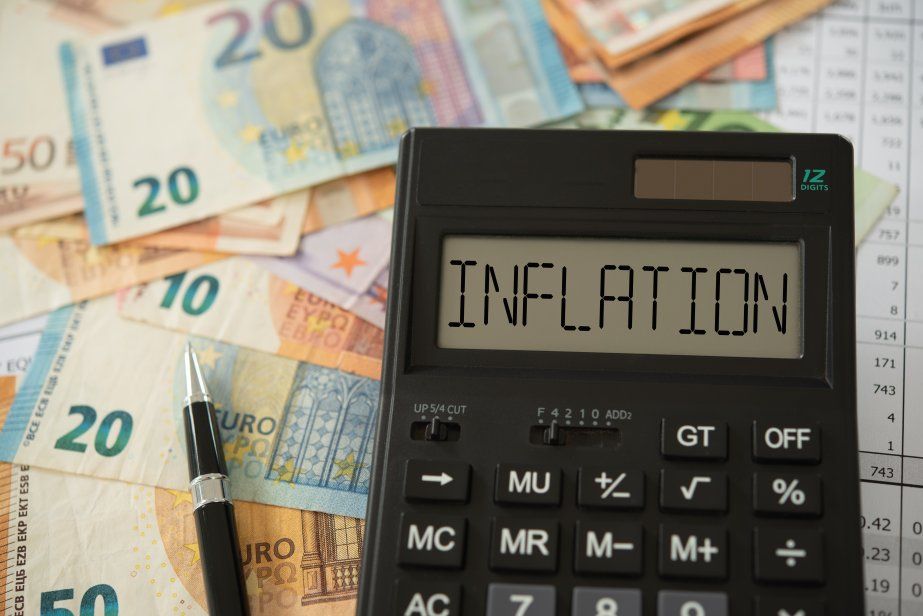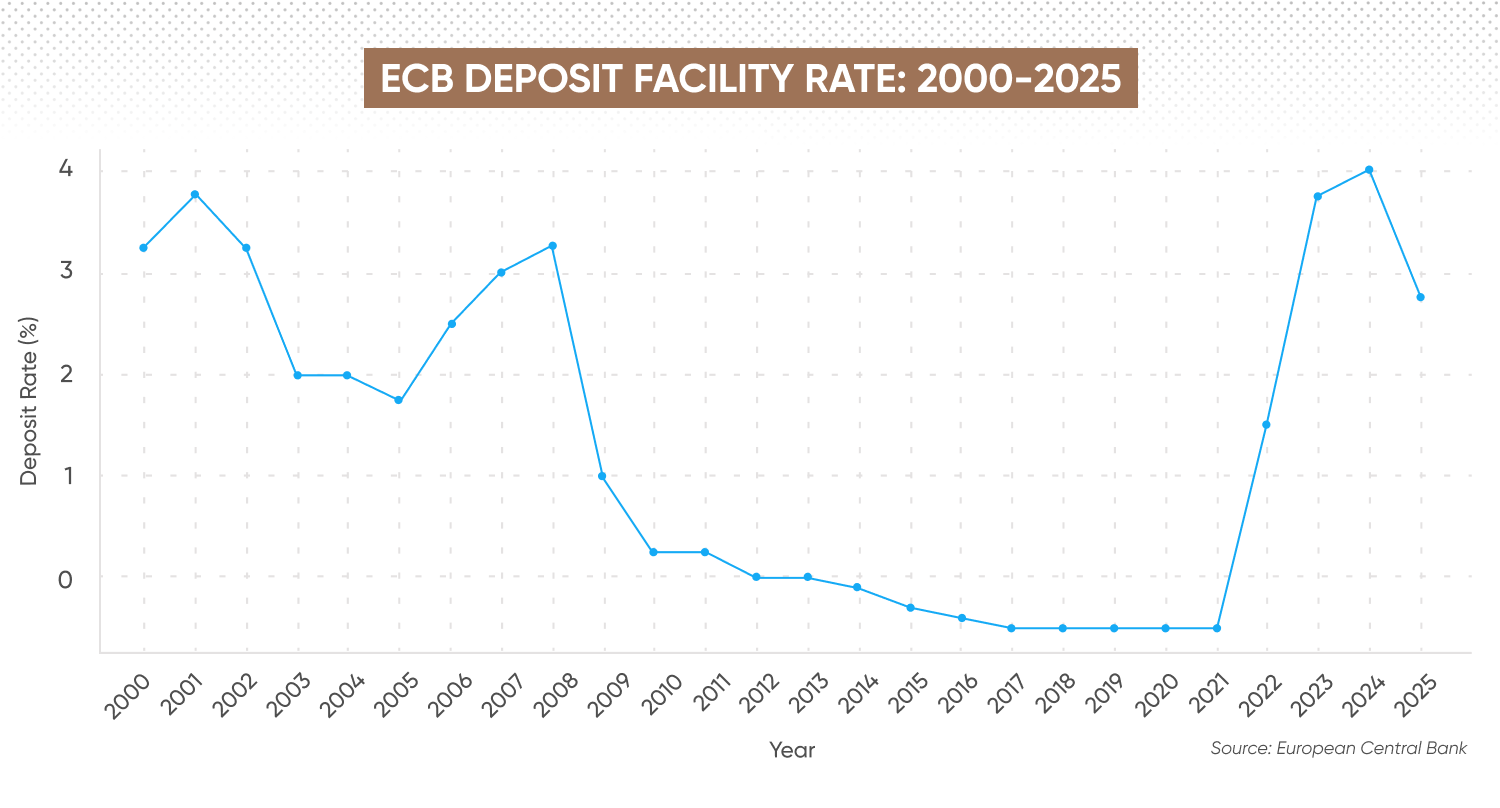ECB interest-rate forecasts – Projections for the next five years
The European Central Bank (ECB) plays a pivotal role in the economic stability of the eurozone, meaning ECB interest-rate forecasts are key to understanding how financial and economic scenarios might evolve.
As the primary monetary authority for the 20 nations that use the euro, the ECB’s decisions have far-reaching implications. One of its most influential tools is the setting of benchmark interest rates, which help manage inflation and support economic growth across the bloc.
ECB interest-rate predictions are closely monitored by investors, policymakers, corporations, and households. These forecasts provide critical guidance for financial planning, investment strategies, and budgeting decisions. As we look ahead to the next five years, understanding how the ECB might act (and why) is essential for navigating the evolving economic landscape.
Create an account Open a demo account
Understanding ECB interest-rate decisions
ECB interest rate decisions are shaped by a range of macroeconomic factors. Chief among them is inflation: the ECB’s primary mandate is to maintain price stability, defined as an inflation rate of 2% over the medium term. When inflation is too high, the ECB raises rates to cool spending and borrowing. When inflation is low or the economy is weak, it cuts rates to stimulate activity.
Beyond inflation, the ECB considers other indicators such as GDP growth, unemployment, wage trends, fiscal policy, geopolitical risks, and global economic dynamics. The overarching goal is to balance inflation control with support for economic stability.
The ECB uses three key policy rates to guide monetary conditions:
-
Main refinancing operations (MRO) rate: this is the rate at which banks borrow from the ECB for one week. It serves as a benchmark for short-term borrowing costs.
-
Deposit facility rate: the interest paid on reserves parked by banks overnight at the ECB. It often acts as a floor for interbank rates.
-
Marginal lending facility rate: the rate for overnight borrowing from the ECB, setting a ceiling for short-term money market rates
Historically, the ECB’s rates have fluctuated in response to crises and recoveries. During the global financial crisis and the European sovereign debt crisis, rates were cut to record lows. In 2014, the ECB even introduced negative interest rates. The tide began to turn in 2022 as inflation surged following the pandemic and energy shocks. A series of rate hikes followed, marking the most aggressive tightening cycle in the ECB’s history.

Current economic climate and ECB monetary policy
As of early 2025, the ECB faces a more nuanced macroeconomic picture. Inflation has come down significantly from the double-digit peaks seen in 2022 and 2023, largely thanks to tighter monetary policy, easing energy prices, and normalising supply chains. The eurozone's annual inflation rate stood at approximately 2.3% in Q1 2025, just above the ECB’s target.
However, economic growth remains tepid. Several eurozone countries are seeing weak domestic demand, constrained by past rate hikes, persistent wage pressures, and global uncertainty. GDP growth is projected to remain below 1% for much of 2025. Meanwhile, fiscal consolidation efforts in countries like Germany and Italy are weighing on public spending.
In this environment, the ECB is signalling a shift from tightening to cautious accommodation. In its monetary policy meetings there has been an emphasis on data-dependency, with President Christine Lagarde noting that any future rate adjustments will be ‘gradual and prudent’. The deposit facility rate, which peaked at 4.0% in 2024, is widely expected to have plateaued.
ECB interest-rate forecasts for the next five years
Wondering about the projected ECB interest rates in five years? While no forecast is set in stone, economists, markets, and policymakers all keep a close eye on likely trends in eurozone monetary policy. The ECB’s future rate decisions will depend heavily on inflation data, growth outlooks, and broader financial conditions. Compare projected US interest rates to see how transatlantic policy divergence might impact global markets.
Below, we explore what analysts expect in the short term and what might shape rates through to 2029.
Short-term ECB interest-rate projections (next 12-24 months)
The ECB could begin cutting interest rates in mid-to-late 2025. Market consensus points to a series of modest rate cuts – perhaps 25 basis points each – bringing the deposit rate closer to 3.0% by the end of 2026. These expectations are supported by:
-
Continued inflation moderation towards the 2% target
-
Weak eurozone growth, especially in southern economies
-
Reduced upward pressure from energy prices and global commodity costs
Several leading institutions have offered specific forecasts:
-
Morningstar anticipates a number of cuts in 2025, bringing the deposit rate to around 1.75%-2.00% by year-end.
-
Reuters economist poll: economists anticipate that the European Central Bank (ECB) will continue reducing interest rates until July 2025 to support the struggling eurozone economy, impacted by impending US tariffs.
-
S&P Global Ratings: S&P projects one rate cut per quarter in 2025, with the deposit rate potentially reaching 2.5% by Q3 of the year.
However, the ECB is expected to proceed cautiously. Its credibility as an inflation-fighting institution remains paramount, and it is wary of easing too quickly and reigniting price pressures.
Medium-term ECB interest-rate outlook (3-5 years)
When it comes to the medium-term interest-rate outlook, forecasts are inherently uncertain, but generally speaking, from 2027 to 2029 the ECB is projected to maintain a more neutral stance. Barring another supply shock or financial crisis, some analysts expect the deposit facility rate to stabilise in the 2.0% to 2.5% range. This reflects a return to what is often called the ‘neutral rate’ – a level that neither stimulates nor restricts economic activity.
Factors that could push rates higher in this period include renewed inflation driven by wage growth or structural changes in global supply chains. Conversely, a sharper slowdown in global trade or a resurgence of deflationary forces could force rates lower again.
Forecasts for this period:
-
ECB's Survey of Professional Forecasters: the ECB’s deposit facility rate (DFR) is expected to decrease below 2.75% in the first quarter of 2025, further decline to 2.00% by the third quarter of 2026, and then gradually rise to approximately 2.25% by 2029.
-
The Organisation for Economic Co-operation and Development (OECD) provides projections for long-term interest rates, specifically focusing on government bonds maturing in ten years. While these projections offer insights into general interest rate trends, they may not directly correspond to the ECB's policy rates.
-
BBVA Market Strategy offers regular updates on the evolution of key interest rates within the Economic and Monetary Union (EMU). Their forecasts encompass monetary curves, swap rates, core sovereign bond yields, and core-peripheral yield spreads across benchmark tenors.
Implications of ECB interest-rate forecasts
ECB interest-rate decisions can have wide-reaching effects – from household finances to business borrowing and market behaviour. As the central bank shifts toward easing, understanding who benefits (and how) can help you plan ahead. Here’s what falling rates could mean for consumers, companies, and investors.
For consumers
The ECB’s rate decisions have a direct impact on personal finance. In a falling rate environment:
-
Mortgage rates may decline, especially for variable-rate products. This could offer relief to homeowners after a period of sharp increases.
-
Savings rates tend to fall as well, making it less attractive to keep cash in deposit accounts.
-
Personal loans and credit card borrowing may become more affordable, encouraging consumption.
As the ECB is likely to cut rates gradually, consumers can expect a slow return to more manageable borrowing costs – but not the ultra-low rates of the 2010s.
For businesses
Lower interest rates typically reduce the cost of corporate borrowing. This is good news for businesses looking to finance expansion, hire staff, or invest in innovation. However, the pace and extent of rate cuts will be crucial.
-
Small businesses that rely on bank lending may see improved credit conditions.
-
Larger corporations may find corporate bond markets more attractive as yields fall.
-
Financial planning will require greater agility, particularly in sectors like construction, autos, and real estate, which are highly rate-sensitive.
That said, persistent economic sluggishness may dampen business confidence and reduce the appetite for borrowing even if rates decline.
For traders/investors
ECB interest rates shape asset prices across the board:
-
Stock markets tend to benefit from falling rates, as lower yields make equities more attractive and improve corporate profitability. Learn how to trade stocks if you’re new to equities.
-
Bond yields will likely fall in tandem with ECB cuts. Investors holding long-duration bonds could benefit from capital gains, but new buyers will face lower yields.
-
Forex markets will be influenced by interest rate differentials. If the ECB cuts more aggressively than the US Federal Reserve or the Bank of England, the euro could weaken against the dollar and pound. See the latest euro forecast for more insight into currency movements.
In short, investors need to position themselves for a gradually loosening monetary environment, balancing yield-seeking behaviour with caution about economic headwinds.
Read our guide to forex trading to help you understand how rate shifts impact FX pairs.
EUR/USD live exchange rate
ECB interest-rate policy: the conclusion
The next five years are expected to mark a new phase in the ECB’s policy journey. After a historic tightening cycle, the central bank is now preparing to pivot toward more accommodative territory – albeit at a cautious pace.
Short-term interest rates are likely to begin falling in 2025, with the deposit facility rate potentially settling between 2.0% and 3.0% over the medium term. While this would ease some of the financial strain on consumers and businesses, the ECB’s path is far from guaranteed. It must navigate inflation risks, geopolitical uncertainty, and fragile growth in a complex and interconnected global economy.
For households, firms, and investors, ECB interest rate projections remain a critical barometer for planning ahead. While the days of zero or negative rates may be over, a more balanced and predictable rate environment could foster greater stability in the eurozone over the long run.
Explore our full range of CFD markets available for trading as conditions evolve.
Looking for the latest IPO activity? Explore a full list of upcoming and recently launched IPOs.
FAQ
What is the ECB interest rate?
The ECB interest rate usually refers to one of the ECB’s key policy rates – most commonly the deposit facility rate, which is the rate banks receive for overnight deposits. The ECB also sets the main refinancing operations rate and the marginal lending facility rate. These rates influence borrowing costs, lending activity, and inflation across the eurozone.
How often does the ECB set interest rates?
The ECB reviews and potentially adjusts interest rates every six weeks during its scheduled monetary policy meetings. Decisions are based on the latest economic data, including inflation, GDP growth, and financial market conditions. Any rate changes are announced immediately after these meetings.
Are interest rates projected to go down?
As of 2025, many analysts expect the ECB to gradually lower interest rates in the coming years. With inflation easing and economic growth slowing, the ECB is widely anticipated to begin cutting rates from the highs reached in 2023-2024. However, the pace and extent of any cuts will depend on incoming data and evolving conditions in the eurozone economy.